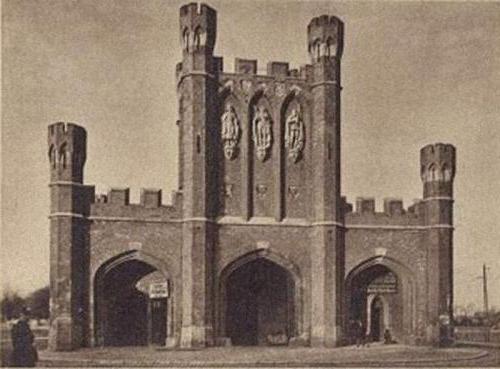The Royal Gate. Kaliningrad
The Royal Gate (Kaliningrad) is one of thethe most famous architectural landmarks of the westernmost city of Russia. In appearance, the structure resembles a triumphal arch or a miniature hunting castle.
A Brief History of the Fortifications of Kaliningrad
The first castle on the banks of the Pregoli River arosein the middle of the XIII century. However, the idea to turn the whole of Königsberg into an impregnable fortress arose from its inhabitants at the beginning of the XIX century (after it was easily occupied by Napoleon's troops). In 1841 the city was visited by the monarch Friedrich Wilhelm IV, to which the townspeople asked to build around the complex of powerful fortifications.
Soon large-scale works onthe construction of fortifications of Koenigsberg, which was to become a reliable stronghold of East Prussia. The city ring of fortifications was divided into several fronts. Each of them included earthen ramparts, bastions, towers, artillery positions, as well as gates for passage.

With the development of artillery, it was decided to encircleKoenigsberg is also a belt of forts. It was supposed that they would additionally defend the city with the help of distant shelling of the enemy. Soon in the vicinity of modern Kaliningrad grew 15 brick forts (12 large and three small). All of them were connected by a ring road with a length of 43 km.
The twentieth century was a period of rapiddevelopment and modernization of weapons, as well as techniques for conducting military operations. Thus, the fortifications of Koenigsberg are very obsolete and, in fact, they have not fulfilled their supposed role in history.
In the early twentieth century, the internal defense beltKoenigsberg was bought by the city administration from the military. Most of the fortifications and bastions dismantled, the shafts turned into streets and boulevards. Fortunately, the Royal gates survived. They will be discussed further on.
The Royal Gate (Kaliningrad): description and location
To our days in Kaliningrad-KoenigsbergThe seven gates of the inner belt of fortifications, dating back to the mid-19th century, were preserved. These are the Rosgarten Gate in the north, the Ausfal and the Railway in the west, the Brandenburg (in the southwest), the Friedland (in the south), the Zakheim and the Royal Gates (in the east). All of them were built in the period from 1840 to 1850 in the Neo-Gothic style.
The Royal Gates are symbolic forcities, they are the most beautiful and expressive among all the rest. The author of the structure is General Ernst Ludwig von Aster. The sculpture was made by Wilhelm Ludwig Stürmer.

The gates are located on the Lithuanian shaft, between the bastion "Grolman" and the channel of the New Pregoal.
History of the construction of the Royal Gate
The gate received its name from the name of the road of the same name. Royal it was called because the Prussian kings were heading along it from the city (the road led to the suburb of Devau).
Laying the first stone of the future structurewas held in 1843. At the same time, King Friedrich Wilhelm IV himself was present. At the time of construction, earthen shafts adjoined the gates on both sides. Later, with the development of road transport, they were leveled. The road was laid next to the brick building. Thus, the gate turned out to be an isolated, detached building.

By the early 90's, the Royal Gate stronglydecayed and demanded a serious reconstruction. Restoration work began only in the autumn of 2004. About 20 million rubles were allocated for them from the budget.
Features of architecture and interesting facts
The gate is a structure of redbrick, consisting of a wide passage (4.5 meters) and casemates, located on each side of it. The building on the outside is reinforced with embrasures. Horizontally the gates are dismembered by a cornice belt in two parts. The upper edges of the casemates' roofs, as well as the passage, are crowned with battlements and miniature turrets.
The upper tier of the gates is decorated with grooves in which the sculptures of King of the Czech Republic Otakar II, the Prussian King Friedrich I and the Duke of Prussia Albrecht I.

In 2005, after the completion of the restoration work, a case with a message to the descendants was laid in the wall of the Royal Gate. One of the entries in it belongs to Russian President Vladimir Putin.
According to one of the versions, it is in the Royal Gate that there are numerous valuables hidden by the German army when retreating from the city in 1945.
The Royal Gates: The Museum and the Time of its Work
In the winter of 2005 the gate became a branch of the MuseumWorld ocean. In the building there were several expositions devoted to the development of the fortifications of the city, as well as the visit to Kaliningrad by various well-known personalities, in particular, the embassy of Tsar Peter the Great to Europe.
The museum also constantly hosts variousevents, solemn ceremonies and meetings of foreign guests. An original "gateway" in Russia for the Western colleagues were the ancient Royal Gates. The museum address: Frunze Street, 112. Visit its exposition is available daily from 11 to 18 hours (except Monday and Tuesday).








